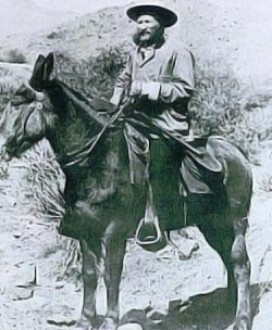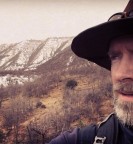Battle of Turret Peak

The Bloody Basin is a physiographic region north of Perry Mesa, approximately 100 km north of Phoenix, Arizona, and was named for a series of bloody skirmishes between the U.S. Army and local Native Americans. The Tonto Basin Campaign was organized by General George Crook in 1871 in an attempt to put an end to the numerous small fights between Euroamerican settlers and Apache and Yavapai in central Arizona. The campaign’s purpose was to force the native population back on to reservations, with the Battle of Turret Peak being the turning point of the campaign.
Although many believe that the name Bloody Basin is associated with the Pleasant Valley War between the Tewksbury and Graham families (Benore 2013), who ran sheep and cattle outfits, respectively, this is likely not the case. Bloody Basin probably got its name from the Battle of Turret Peak, which occurred on March 27, 1873 (Michno 2003). The Yavapai and Tonto Apache, who were highly mobile, unpredictable, and daunting foes, were feared by white settlers because of their cunning, ferocity, and endurance (Benore 2013; TNA 2015). They showed little mercy to the interloping settlers who had moved into their traditional lands beginning in the 1860s.
Having frequently skirmished with local Native Americans for a decade, with mixed results, the U.S. Army organized the Tonto Basin Campaign. In June of 1871, General George Crook was assigned to the area and used mobile Army detachments led by Apache scouts. Crook's assignment was to track down members of the tribes and forcefully return them to the reservations. Over the course of the operation, there were over twenty clashes.
On March 11, 1873, a band of Tonto Apaches attacked a party of three men. Two were killed, but one of the men was taken alive and tortured. According to accounts by Major Azor H. Nickerson, the Apaches took the man up to a sheltered spot among the rocks, stripped him of his clothing, tied his hands behind him, fastened his feet together and commenced to torture him by shooting arrows into his naked body, taking care not to hit vital spots (Michno 2003). The atrocity inspired a punitive expedition led by Captain George M. Randall of the 23rd Infantry that tracked the hostiles to Turret Peak, a Yavapai stronghold east-southeast of Horseshoe Ranch in the Bloody Basin.
On March 27, 1873, a group of soldiers and Apache scouts under the command of Captain George M. Randall crept up Turret Peak in the dark of night. Randall had the men crawl on hands and knees to avoid alerting the Apache group (Michno 2003). Shortly after midnight they saw the glimmer of fires amid the rocks scattered about on the summit. Waiting until dawn, the soldiers charged and surprised the Apache at a ranchería near the crest of the mountain. It is reported that the Apaches were so panic-stricken that many of the warriors jumped off of the precipice to their deaths. Those who resisted were quickly killed or surrendered. Estimates run between 26 and 57 Apache killed, with many more injured. A few civilians were found in a nearby cave below the peak after the fighting had stopped, killed accidentally by the covering fire or rolling rocks. No soldiers were killed, and several were later awarded the Medal of Honor. Two weeks after the battle, on April 6, many of the Apache surrendered to General Crook at Camp Verde and were removed down to the San Carlos Reservation, not to return until several decades later. The attack at Turret Peak proved demoralizing to the Yavapai and Apache people.
References
Benore, Loretta 2013 - In Days of Yore: The True Story of How Bloody Basin Got Its Name. Verde Independent, July 24, 2015.
Michno, Gregory 2003 - Encyclopedia of Indian Wars: Western Battles and Skirmishes, 1850–1890. Missoula: Mountain Press Publishing Company.
The Natural American (TNA) 2015 - Bloody Basin and Beyond. Electronic Document, http://thenaturalamerican.com/bloody_basin_and_beyond.htm. Access July 24, 2015.
Download Battle_of_Turret_Peak_121515.pdf- Tagged In: Arizona Game & Fish Department, George Crook, Native American

Joshua S. Edwards
Josh is the Principal Investigator for Cornerstone Environmental in Flagstaff, Arizona. He is an archaeologist, geomorphologist, and faunal analyst specializing in research topics oriented toward Southwest prehistory. This has included research on changes in prehistoric settlement patterns and subsistence strategies, anthropogenically induced paleoenvironmental change, and fluvial system dynamics and their effect on cultural landscapes. His work has been geographically focussed in Arizona and western New Mexico, and includes projects in California, Nevada, Colorado, Utah, Wyoming, and Texas. Also having a passion for history, Josh loves reading about local historical events and people. This has led him to learn the intricacies of historic preservation. Applying these principals has been an ongoing challenge and has fulfilled his desire to continue learning and expanding his abilities within his academic and professional field.










